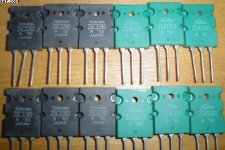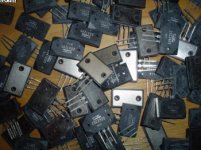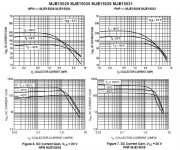Fernando, SKA = Simple Killer Amp
Masta, I haven't built the Leach myself, from what i have heard, both, leach and symasym are uncolorized.
You could ask Terry (still4given), he has directly compared Leach to symasym. IIRC, he prefered the symasym sonically. The Leach is definitely much more powerful, the symasym simpler and cheaper.
Jacco, the MJL21193/4/5/6 might be good "ancient" devices, they need higher bias anyway. And, they sound "lovely", and are one of the toughest devices available. Only some MT200 Sanken have even higher SOA.
Mike
Masta, I haven't built the Leach myself, from what i have heard, both, leach and symasym are uncolorized.
You could ask Terry (still4given), he has directly compared Leach to symasym. IIRC, he prefered the symasym sonically. The Leach is definitely much more powerful, the symasym simpler and cheaper.
Jacco, the MJL21193/4/5/6 might be good "ancient" devices, they need higher bias anyway. And, they sound "lovely", and are one of the toughest devices available. Only some MT200 Sanken have even higher SOA.
Mike
MikeB said:"ancient"
i had this in mind, with heatpipes and fans.
(just bumped into a set of heatpipes on ebay, see the Stax da100m thread)
The Krell output boards should do
(if i can still find a gerber or a pdf of the things)
Attachments
jmateus said:Hello Bremen
I'm just curious, how do you rate the Leach amplifier in terms of Hi-fidelity?
I remember years ago I built The tiger amplifier from Prof. Leach and
to be honest with you it didn't impressd me whatsoever. Now that I
built every conceivable hifi amplifier I have my reservations about the quality of the schemtics I find on the net.
Besides the Symasym that didn't impress me at the very beginning
(That was the experimental version), Mike made a few modifications
that gave the actual rich tonal effect to his amplifier. I built it in two
different versions and am really happy with the results.
Actually I consider this amplifier one of the best (if not the best) amps I built.
Now I'm looking for something more porwerful, about 150 watts per
channel capable of driving my beautiful speakers in a very tiny room
(it's a joke, now), the speakers are good enough but a very powerful amplifier would call the attention to the neighbours and I don't want that.
However, a powerful amplifer, no more than 150 Watts, would
give all the headroom I want to listen to it at low levels without
distortion. That's why I'm asking about the Leach qualities.
I can see on the Leach board are transistors that seem to be
obsolete, the round cases as the 2N3053. Are they replaceble?
In any case, if you don't mind I would like to know more about it.
Thanks
Although I can't directly compare (ask Terry), I can say:
I use my Leach with Tannoy HPD385s and it is the best sound I've heard this side of a professional studio, and much too powerful for my neighbours, though I haven't compared it with high-end commercial amps in my house. I use separate 40V 630VA transformers for each channel, and a lot of capacitance in the PSU.
I used modern transistors as recommended by Jens Rasmussen, with TO3 MJ21193/4 outputs, have a look here:
http://www.diyaudio.com/forums/showthread.php?s=&threadid=52459&perpage=10&highlight=&pagenumber=1
I can let you have the gerbers for the boards if you like, or get you a couple made next time I place an order with Futurlec.
I'm going to use an active crossover at some point, hence my interest in symmasym.
hope this helps,
cheers
One of the best
My power device preference list:
Fujitsu:
2SA1075-2SC2525
2SA1076-2SC2526
Toshiba:
2SA1094-2SC2564
2SA1095-2SC2565
Sanken:
2SA1215-2SC2921
2SA1216-2SC2922
2SA1295-2SC3264
(maybe because i have them
 )
)Nando,
Jens must be having a baby, he is cleaning out everything.
Last time i looked he still had small and big leach boards.
I have 1 of the big Leach boards assembled(not entirely original) and have listened to it with a low bias setting on an average loudspeaker.
(i'm not exactly sure what is considered an average loudspeaker on this forum)
The sound of the Leach circuit/board layout is quite good.
Jens sold me a set of boards really dirt cheap, suppose he is selling them now at give-away prices.
Not saying they are better than a SymAsym, i'm in class A only so i haven't done the SymAsym yet.
jacco vermeulen said:
My power device preference list:
...
2SA1216-2SC2922
...
I have some of these - would you recommend them for symasym? What value for C14 if so?
Leach amp
Hi Bremen
Thanks for your considerations about the Leach. I've heard good
and not so good things about it that's why I asked for your opinion.
About the boards, one of the things that threw me off about this amp
was the the way the outputs were mounted (on the Jens layout)
didn't do too much for me. I really don't like the outputs mounted
under the board against the heatsink. I think it's a poor way to do it
we never know if the sil pads are mounted correctly or not and if
the outputs are properly isolated from the aluminum.
It must be a better way to do it but for now I think this the only
layout around for the Leach, except for the original from Prof. Leach
to be used with TO3 transistors.
About the crossover you're planning to use, the XM9 from Marchand
is a good bet, I myself have one working flawlessly for quite some
time. I'm using OPA2134 IC's, good tonal caracteristics as opposed
to LF353 with which I built it originally.
So, I'll wait for your board order and please let me know when the time comes
Thanks
Hi Bremen
Thanks for your considerations about the Leach. I've heard good
and not so good things about it that's why I asked for your opinion.
About the boards, one of the things that threw me off about this amp
was the the way the outputs were mounted (on the Jens layout)
didn't do too much for me. I really don't like the outputs mounted
under the board against the heatsink. I think it's a poor way to do it
we never know if the sil pads are mounted correctly or not and if
the outputs are properly isolated from the aluminum.
It must be a better way to do it but for now I think this the only
layout around for the Leach, except for the original from Prof. Leach
to be used with TO3 transistors.
About the crossover you're planning to use, the XM9 from Marchand
is a good bet, I myself have one working flawlessly for quite some
time. I'm using OPA2134 IC's, good tonal caracteristics as opposed
to LF353 with which I built it originally.
So, I'll wait for your board order and please let me know when the time comes
Thanks
jmateus said:it's a poor way to do it
Not part of this thread, but there are very good reasons for doing that.
A solution for mounting such boards easier is bolting a solid piece of rectangular aluminium on a heatsink, and mounting the devices on both sides to that. (drilled and tapped holes)
e.g. for the small Leach boards designed by Jens, with 6 output devices, a 1.25" x 2" x 3" piece of solid aluminium bar would do.
Probably only costs 1/2" of additional case space, between amp board and heatsink.
Overhere i can buy that stuff by the foot, don't need to machine it to size but saw it to length only.
(12" or larger diameter trespa saw blade on a circular saw table)
For a flat mounting surface it's easy to grind the side on a mirror with grinding paste, worked great for engine heads. Feeling expensive ? use diamond paste)
A routine that has been used many times by pro audio manufacturers.
jacco vermeulen said:
A solution for mounting such boards easier is bolting a solid piece of rectangular aluminium on a heatsink, and mounting the devices on both sides to that. (drilled and tapped holes)
e.g. for the small Leach boards designed by Jens, with 6 output devices, a 1.25" x 2" x 3" piece of solid aluminium bar would do.
Probably only costs 1/2" of additional case space, between amp board and heatsink.
Overhere i can buy that stuff by the foot, don't need to machine it to size but saw it to length only.
(12" or larger diameter trespa saw blade on a circular saw table)
For a flat mounting surface it's easy to grind the side on a mirror with grinding paste, worked great for engine heads)
A routine that has been used many times by pro audio manufacturers.
These (admittedly not entirely disinterested) guys reckon you mess up the heatflow that way:
http://www.conradheatsinks.com/technical-details.html
The link doesn't work for me right now, but i suppose you are referring to L-shaped mounting brackets.
I was not, the sizes of the example i gave is next to twice the contact surface of 6 output devices, or more.
As it would be located right on the centreline of the board the bar would also be mounted halfway on the heatsink.
With a very flat surface that is tightly mounted with bolts and thermal blob on the heatsink, heat transfer speed may likely be better than a Conrad heatsink flange.
(heat transfer depends on thermal crossing resistance, and the square surface the heat flows through. Thermodynamics 101)
I was not, the sizes of the example i gave is next to twice the contact surface of 6 output devices, or more.
As it would be located right on the centreline of the board the bar would also be mounted halfway on the heatsink.
With a very flat surface that is tightly mounted with bolts and thermal blob on the heatsink, heat transfer speed may likely be better than a Conrad heatsink flange.
(heat transfer depends on thermal crossing resistance, and the square surface the heat flows through. Thermodynamics 101)
contact surface
If you can remove the anodising surface locally it would be better for the heat transfer if you mount a bar, not a nice job for doing at home normally...
Loek
If you can remove the anodising surface locally it would be better for the heat transfer if you mount a bar, not a nice job for doing at home normally...
Loek
jacco vermeulen said:
With a very flat surface that is tightly mounted with bolts and thermal blob on the heatsink, heat transfer speed may likely be better than a Conrad heatsink flange.
You're probably right - would have to be *very* flat and *very* tightly mounted though.
Let me explain,
I will not use anything for PA, I don't need big and awful speakers... I just need a Powerful Hi-Fi.
So, I've already ordered the components for Symasym, and I'll build it and probably will be enough. If it's not enough I'll try SKA. But forget PA, I don't like it and I'll not use it, not even necessary.
3 weeks to the components arrive from farnell
Off Topic:
Mike and Destroyer, speacially Mike, I'm impressed with all your attention to this topic, is so nice to see you giving all this support ! I feel safe to build it
Regards,
Fernando
I will not use anything for PA, I don't need big and awful speakers... I just need a Powerful Hi-Fi.
So, I've already ordered the components for Symasym, and I'll build it and probably will be enough. If it's not enough I'll try SKA. But forget PA, I don't like it and I'll not use it, not even necessary.
3 weeks to the components arrive from farnell

Off Topic:
Mike and Destroyer, speacially Mike, I'm impressed with all your attention to this topic, is so nice to see you giving all this support ! I feel safe to build it

Regards,
Fernando
Hi Fernando,
If you are mounting the amps inside, directly connected to the speakers I have only two concerns:
1. Vibration. Possibly mount the electronics with a compliance between the amp and the box.
2. Ventillation. Try to mount the heat sink fins so they have fresh air.
That's about it. A multi amp system can sound awsome.
-Chris
If you are mounting the amps inside, directly connected to the speakers I have only two concerns:
1. Vibration. Possibly mount the electronics with a compliance between the amp and the box.
2. Ventillation. Try to mount the heat sink fins so they have fresh air.
That's about it. A multi amp system can sound awsome.
-Chris
😀
But about the Heatsink, what is better? Fins outside the box or near the air duct receiving air through the flux ?
But about the Heatsink, what is better? Fins outside the box or near the air duct receiving air through the flux ?
Hi Fernando,
Keep the fins away from the port(s).
You could build a space in the rear for the electronics and cover with plexi to form a tunnel. Space at the bottom and the top.
It could then look really nice and be easy to remove for service. The wires would then permanently attach to the speakers and be sealed properly. Plugs to the amplifiers.
-Chris
Keep the fins away from the port(s).
You could build a space in the rear for the electronics and cover with plexi to form a tunnel. Space at the bottom and the top.
It could then look really nice and be easy to remove for service. The wires would then permanently attach to the speakers and be sealed properly. Plugs to the amplifiers.
-Chris
MikeB said:[B/]
If you have difficulties with some parts, here are some possible
substitutions:
mpsa18: bc550c,2sc2240,bc546b these should do the same job...
2n5401/5551: mpsa92/42, bc639/640, but i i recommend to keep them.
mje15030/1: better not to replace...
output: every highly regarded bjt should do it, sanken, toshiba,
mjl21193/4/5/6...
Mike [/B]
Hello Mike.
Regarding drivers, for Ic in range of 0...2A, hfe is much greatest and more linear in case of 15034/35 than 15030/31. Only after 2A, at 20Vdc, hfe fall much faster for 34/35 but for every other parameters, 34/35 are far more superior.
I know that every semiconductor device that have greatest breakdown voltage are more viable (better passivation) and have much little noise on reverse polarization characteristics than similar one with little breakdown voltage (Vce in particular case of transistors)
In your project, Ic for drivers exceed 2A ?
Thank You.
Attachments
- Home
- Amplifiers
- Solid State
- Explendid amplifier designed by Michael Bittner, our MikeB


